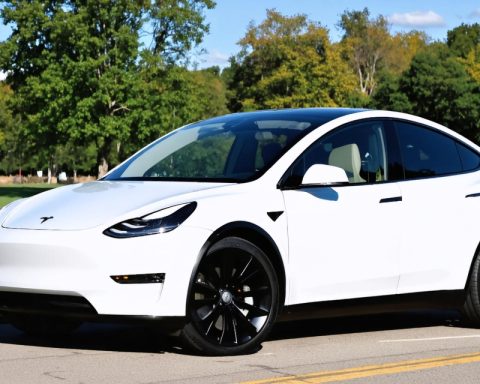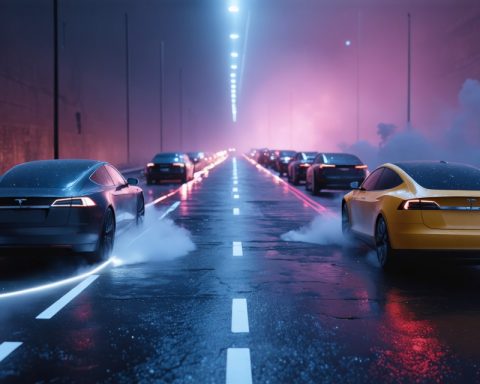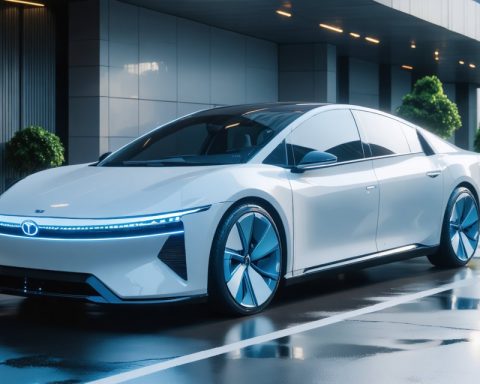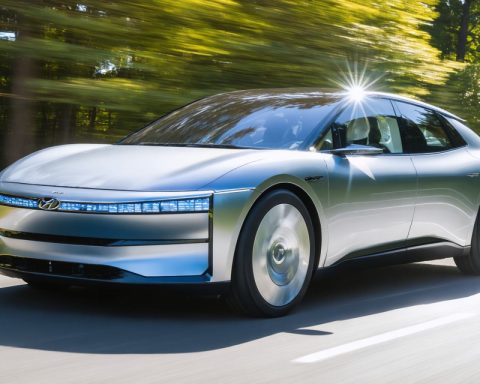- BYD is rapidly emerging as a leader in battery electric vehicles (BEVs), potentially overtaking Tesla in the market.
- BYD’s cutting-edge technology, such as the 1,000-kW ultra-fast charging and 10C rate batteries, surpasses current industry standards.
- The company’s vertically integrated production model enhances efficiency and quality control.
- Strong domestic support and policies favoring innovation boost BYD’s global expansion.
- Tesla faces challenges due to geopolitical tensions, supply chain issues, and declining sales in key markets.
- BYD reported a significant increase in BEV sales, outpacing Tesla in consecutive quarters.
- The electric vehicle industry is witnessing a significant shift, emphasizing adaptability and innovation as key success factors.
In the fast-paced world of electric vehicles (EVs), a new titan is rising from the East. BYD, the formidable Chinese automaker, is rapidly gaining momentum and might soon overtake Tesla as the world leader in battery electric vehicles (BEVs). This shift is driven by BYD’s advanced technology, aggressive expansion strategies, and a vertically integrated production model that sets it apart in a fiercely competitive industry.
Technology as a Catalyst
At the heart of BYD’s ascent is its trailblazing technology. The company’s 1,000-kW ultra-fast charging technology and its revolutionary batteries with a 10C charging rate are setting new benchmarks, surpassing even Tesla’s renowned Supercharger network. These innovations are not only speeding up charging times but also redefining consumer expectations and the industry’s technological limits.
Strategic Growth and Support
Deliberate and calculated strategies have propelled BYD. By embracing a vertically integrated model, the company controls nearly every aspect of its production, allowing for efficiencies and quality control beyond its competitors. Coupled with robust support from domestic policies that favor local manufacturing and innovation, the stage is set for BYD’s ascendancy.
Tesla’s Challenges
While BYD surges ahead, Tesla faces a series of hurdles that might dent its leadership. CEO Elon Musk’s outspoken political views have alienated some consumers in key Western markets. Softening sales figures in the US and Europe further illustrate this growing discontent. Additionally, geopolitical tensions, especially the US-China trade dispute and corresponding tariffs, are complicating Tesla’s supply chain, creating headwinds that are stalling its momentum.
Tesla’s recent delivery figures reflect these challenges. In the first quarter, the company missed Wall Street’s expectations, delivering 336,681 units—a sharp drop from the previous year’s numbers. This decline hints at broader challenges that Tesla must navigate in the coming years.
BYD’s Expanding Reach
In contrast, BYD’s numbers tell a story of growth and potential. The company sold 416,388 passenger BEVs in the first quarter, marking a significant year-on-year growth, even amid industry-wide challenges. This is the second consecutive quarter that BYD has outpaced Tesla in passenger BEV sales, suggesting a tectonic shift within the industry.
In a market that values innovation and reliability, BYD’s strategic foresight and execution are crafting a narrative of success that resonates globally. While Tesla’s star has not dimmed, the stage is set for a thrilling showdown. As we move towards 2025, all eyes are on BYD—poised to potentially reshape the global landscape of electric mobility.
The key takeaway is clear: the future of the electric car market is being written, and adaptability, innovation, and strategic support will determine the victors in this narrative of technological evolution.
Is BYD Set to Overtake Tesla in the Electric Vehicle Race?
Unpacking BYD’s Rapid Ascension in the EV Market
As the electric vehicle (EV) market heats up, all eyes are on BYD, the Chinese automaker that’s threatening Tesla’s global dominance in battery electric vehicles (BEVs). Unveiling advanced technologies, a robust manufacturing model, and strategic growth tactics, BYD is poised to redefine the EV landscape. Here’s a comprehensive analysis of why BYD might soon surpass Tesla as the leader in electric mobility.
Advanced Technology: BYD Sets New Industry Benchmarks
1,000-kW Ultra-Fast Charging and 10C Battery Technology
BYD’s breakthrough in charging technology and battery design may significantly alter consumer experiences and expectations. The company’s 1,000-kW ultra-fast charging capability allows for unprecedented quick charging, far outpacing Tesla’s Supercharger network. Furthermore, BYD’s revolutionary 10C charging batteries offer rapid energy replenishing, enhancing convenience for EV owners.
Strategic Growth and Vertical Integration
Vertical Integration for Superior Control
BYD’s vertically integrated production ensures greater control over supply chain logistics, quality assurance, and cost efficiency. This integrated approach supports sustainability efforts by reducing dependencies on external suppliers, which contrasts with Tesla’s more fragmented production model.
Domestic Policy Support
China’s favorable domestic policies bolster BYD’s innovation and manufacturing. Government incentives encourage local production, placing BYD in a competitive advantage compared to international rivals, including Tesla.
Tesla: Facing Market Challenges
Political Controversies and Geopolitical Tensions
Elon Musk’s political stances have polarized key markets in the West, potentially affecting Tesla’s brand perception. Additionally, the ongoing US-China trade tensions introduce supply chain complexities, hampering Tesla’s expansion and operations.
Market Performance Hiccups
Tesla’s sales and delivery statistics reflect growing pains. In the first quarter, the company reported delivering 336,681 units, falling short of Wall Street’s expectations and hinting at deeper challenges within North American and European markets.
BYD: Consistent Growth Trajectory
Rising Sales Figures
BYD sold 416,388 passenger BEVs in the first quarter alone, a notable achievement amidst global industry challenges. Continually outpacing Tesla in BEV sales, BYD’s growth underscores its potential to lead the market transformation.
Real-World Use Cases and Consumer Benefits
Faster Charging, More Convenience
With faster charging times, BYD’s technology minimizes downtime, catering to consumers who prioritize efficiency. This technological edge directly addresses range anxiety, making EVs more appealing to a broader audience.
Market Forecast and Industry Trends
The global shift towards sustainable transport solutions signals growing demand for reliable and innovative EVs. Analysts predict that Byd’s traction in diverse markets could lead to it comprehensively challenging Tesla’s foothold by 2025.
Conclusion: Quick Tips for Consumers
– Explore Charging Technologies: Consumers should assess the charging capabilities of different EVs, as this influences convenience and long-term satisfaction.
– Consider Brand Stability and Growth: When purchasing an EV, consider the manufacturer’s stability, growth trajectory, and regional support.
– Stay Updated on Incentives: Look out for government incentives that could impact pricing and accessibility of EVs in your region.
Recommendations for Potential EV Buyers
– Assess Charging Infrastructure: Adopt vehicles compatible with emerging charging technologies for future-proof ownership.
– Research Environmental Impact: Opt for companies with strong sustainability missions, like BYD’s integrated production model.
– Monitor Market Trends: Keep an eye on industry forecasts to anticipate shifts in vehicle technology and capacity.
For more insights into the global EV market, visit the BYD official site or explore other leading industry trends at Tesla’s official site.















